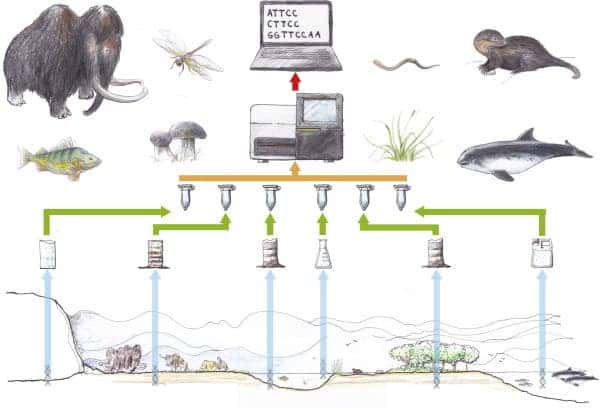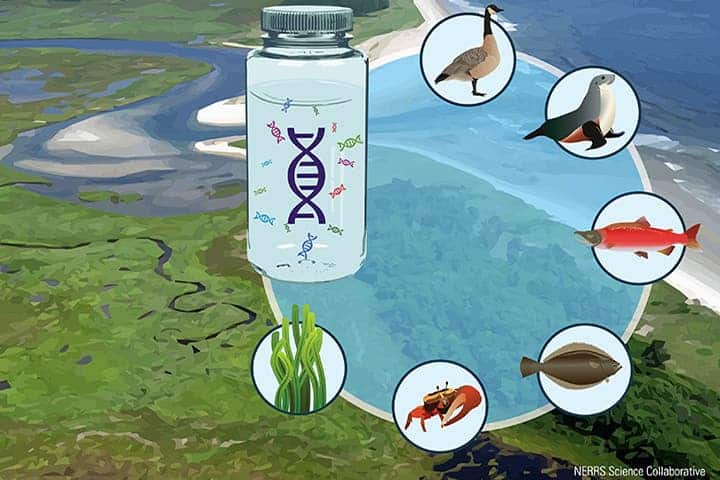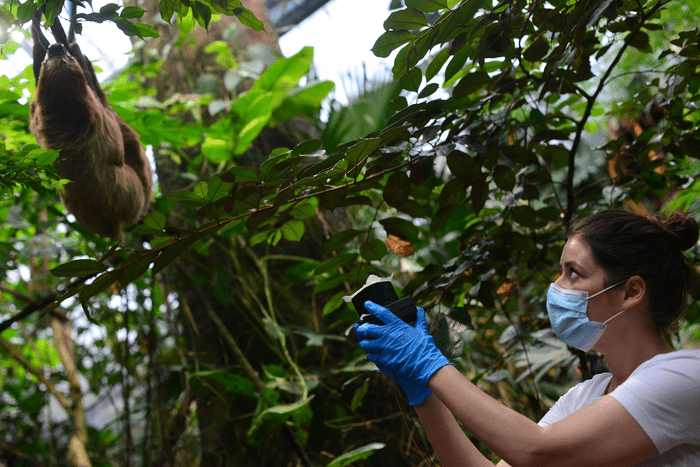
Our planet is teeming with life — and it leaves traces everywhere it goes. These include conspicuous markings such as pawprints or abandoned nests, but also other traces invisible to the naked eye such as DNA. In the past decade, biologists have had great success identifying animal species and their abundance using environmental DNA (eDNA) gathered from the aquatic environment. Now, two different research groups using two different methods have independently shown that it is possible to do the same with eDNA sucked out of the air.
The blueprint of life is everywhere, even in the air you breathe
Biology fieldwork can be incredibly thrilling, but it’s always exhausting. Measuring fish, collecting insects, catching snakes, you name it — on and on for weeks or even months. That may be a blessing if you’re the kind of scientist who loves nature and the great outdoors, but it’s terribly frustrating when you have to work in very remote areas on the lookout for elusive species — and this is exactly where environmental DNA can come in to save the day (and your Ph.D. thesis).
Environmental DNA — essentially genetic material obtained directly from environmental samples (soil, sediment, water, etc.) without any obvious signs of biological source material — has emerged as an invaluable tool for monitoring past and present biodiversity. The method was first employed in sediment, revealing DNA from extinct and extant animals and plants, but has since been obtained from various terrestrial and aquatic environmental samples. However, air samples have been rarely used for proper eDNA analysis due to the inherent challenges dealing with a medium so prone to contamination and, well, in a constant flow of motion — that’s until now.

Two independent groups of researchers, one led by Assistant Professor Elizabeth Clare from York University in Canada, the other led by Associate Professor Kristine Bohmann from the Globe Institute at the University of Copenhagen, have provided the most robust evidence thus far that air eDNA can be a reliable tool for assessing biodiversity.
“My research group does lots of fieldwork in remote areas with difficult and elusive species. We were motivated partly because we face the challenge of monitoring these animals all the time. We also have a history of working to develop new methods for biodiversity monitoring. I was mainly motivated because I was asked to write a report for one of the UK government agencies on how we can best use DNA in future biomonitoring. I got to writing about sources of eDNA and realized that air was a largely unexplored area, particularly for animals. I decided to take up that challenge myself,” Clare told ZME Science. “The really exciting thing about this is just how well it worked. Both teams independently tried to do this, and use different approaches… but both were highly successful. This is really good evidence that this is a viable method. That it will work on a large scale.”
“In my group, we work with different aspects of environmental DNA analyses, including exploring novel eDNA sample types. One such novel sample type is air. Air surrounds everything and we set out to explore whether it is possible to filter animal DNA from the air and use it to detect them. If this was indeed possible we would not only push the boundaries for what can be done with environmental DNA but also demonstrate a novel and non-invasive tool to complement existing methods for monitoring terrestrial animals – something of great importance to inform conservation efforts,” Bohmann told ZME Science.
Zoos: the perfect testing ground for airborne eDNA
Both research teams selected local zoos as their sampling sites, which proved to be the perfect testing grounds for this ambitious undertaking. Zoos have an exact headcount of all the animal species and individuals they house. They also have exotic species that are impossible to find in the local urban environment or even the wild in their respective countries. “We knew that if we detected Tasmanian devils then the likelihood of that being anywhere else in Copenhagen would be slim,” Bohmann said.
Bohmann and doctoral student Christina Lynggaard collected air samples from three different locations at the zoo using three different sampling devices (a commercial water-based vacuum and two blower fans with filters attached). They sucked and filtered air from the okapi stable, the Rainforest house, and outside between the different zoo enclosures.
Elsewhere in the UK, at Hamerton Zoo Park, Clare’s team used vacuum pumps to collect more than 70 air samples from various locations around the zoo, both inside animal sleeping dwellings and outside in the general environment.
Better than camera traps

Clare’s study identified 25 different species of animals, 17 of which were zoo species such as tigers, lemurs, and dingoes. Some of the zoo animals they detected lived hundreds of meters away from the testing sites, despite the sizable drop in concentration, but this showed that the method can monitor species over a large surface area from a single whiff of air.
Bohmann detected 49 species from 40 samples, ranging from mammals and birds to reptiles and fish. These included two-toed sloths, boas, rhinos, ostriches, and guppies in the nearby pond. “We were absolutely amazed by the taxonomic range of the animals that we detected – from mammals to birds, reptiles, amphibians, and fish. And we were blown away by the number of detections: we detected no less than 6-21 animal species per sample,” she said.
The monitoring surface area could actually be much greater for air eDNA than anyone dared to believe. Both groups detected species that weren’t kept at the zoos but were native to the surrounding area. Although they live outside Hamerton Zoo, the scientists found evidence of the Eurasian hedgehog, a species endangered in the UK. The air samples from Copenhagen Zoo contained DNA belonging to the water vole and red squirrel. They also found DNA from chickens, cows, horses, and fish — which all makes sense since these are common food items for zoo animals.
But these remarkable results required more preparation and due diligence than other eDNA sampling methods. Obviously, air surrounds everything so the researchers had to take special precautions to avoid contaminating their collected filters both on route and inside the lab. This included sampling the air inside the lab itself, whose readings acted as a control.
“We set up a completely new lab dedicated to this project and this for us unknown eDNA sample type. Here we employed very strict guidelines known from ancient DNA workflows and we even sampled the air in the lab to be sure we did not have any contaminating DNA in the air. We also employed different negative controls and importantly positive controls of species not known to be in the zoo or surrounding area. This enabled us to trace whether there was any contamination between samples, simply because we would then see the positive control species appearing in our samples,” Bohmann said.
In the UK, Clare had to also deal with COVID restrictions besides the challenges of working with air samples. But it was all well worth it in the end — luckily the adorable zoo animals lent a helping paw.
“I was the only person allowed at the zoo during most of the collection and I traded off with my student and technician Frances. It was mid-winter and there was some light snow. That was actually really fun. The animals were super excited to have visitors and deeply curious about what we were doing. I had some equipment stolen by a curious tyra. I had lunch watching maned wolves wander around. That was special,” Clare said.
Biodiversity monitoring might never be the same again
Air sampling seems poised to change environmental monitoring and conservation for the better, joining the ranks of tried and tested eDNA methods like aquatic and terrestrial.
“The field of aquatic eDNA biomonitoring was kicked off over a decade ago and since these first proof-of-concept studies, it has grown tremendously. Having demonstrated air as a novel eDNA sample type for vertebrate monitoring is of course something we can do because we stand on the shoulders of all these technological developments and I think that is also what will enable us to adapt this tool to natural environments – and I can’t wait to get started!” Bohmann said.
“On land, we use eDNA from many sources. It’s been collected from soil, honey, snow, rain even from spraying leaves and collecting the runoff water. But we don’t have a real general approach the way the aquatic community does. We really need to look at how that technology has developed to guide the next steps in refining the technique for air. We have the advantage that we can model our approaches after theirs,” Claire said, adding that “the really nice thing is that now that the idea is out there we are seeing this growing fast. There are studies emerging collecting airborne DNA from plants, insects, birds… it’s going to develop quickly and that’s exciting.”
And the groundwork has been laid out not by one but two different research groups independently. How the two research teams thought of the same study at right about the same time is another story in itself.
“I think at first we were both shocked! Our research teams have known each other for a long time, and have collaborated before. It was a total surprise to find out we were both doing the same study. It was more shocking to find we were both doing it the same way at the same time and had even written and submitted papers within a few hours to the same location! I’ve only heard of that happening once before,” Claire said. “We were extremely lucky that Current Biology saw that very significant advantage as well and while the papers were treated independently and fully peer-reviewed like any other, they agreed that both would be on the same timeline. We are extremely excited that they will appear together and at this example of scientific cooperation. More of this needs to happen!”
“I cannot wait for the day where we can meet at a conference over a large beer and celebrate our achievements and talk about the journey we have been on together,” Bohmann added.
References:
- ‘Measuring biodiversity from DNA in the air’ Elizabeth L. Clare, Chloe K. Economou, Frances J. Bennett, Caitlin E. Dyer, Katherine Adams, Benjamin McRobie, Rosie Drinkwater, Joanne E. Littlefair Current Biology (2021). DOI: 10.1016/j.cub.2021.11.064
- ‘Airborne environmental DNA for terrestrial vertebrate community monitoring’ Christina Lynggaard, Mads Frost Bertelsen, Casper V. Jensen, Matthew S. Johnson, Tobias Guldberg Frøslev, Morten Tange Olsen and Kristine Bohmann Current Biology (2021). DOI: 10.1016/j.cub.2021.12.014






